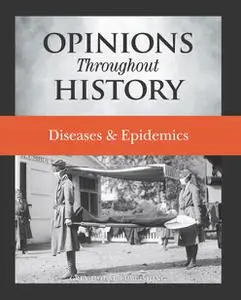Micah Issit, "Opinions Throughout History: Diseases & Epidemics"
English | ISBN: 1642658448 | 2021 | 600 pages | PDF | 16 MB
English | ISBN: 1642658448 | 2021 | 600 pages | PDF | 16 MB
Opinions Throughout History: Disease & Epidemics traces the history of some of the most impactful diseases in human history, such as smallpox, measles, the bubonic plague, and HIV, and looks at how these viruses and bacterial plagues affected American politics and culture. The book will also explore the rise and the spread of the anti-vaccination and science skepticism movements and their relationship to American and global public health. The history of American diseases and epidemics will be compared to the COVID-19 crisis, the deadliest pandemic in modern U.S. history, which has provided a clear example of how governments and the other organs of the state can help or hinder the international goal of stamping out disease.
This new edition starts with a detailed Introduction that gives an overview of major outbreaks that decimated populations and established the makeup of the modern world as well as discussing how societies over time have reacted to such events. A comprehensive Timeline highlights significant events from the possible presence of smallpox in Egypt’s New Kingdom in 1570 BCE to news of the first successful phase III trials of a COVID-19 vaccine in 2020.
The 29 chapters that follow detail history’s most significant diseases and epidemics and trace scientific discoveries from microbiology to germ theory to vaccination— tools that allowed a level of control over disease outbreaks. Coverage follows patterns of science skepticism and refusal by some to engage in safe practices like quarantine, social distancing, and mask-wearing. Governments who have downplayed the severity of an outbreak to avoid panic and prevent economic decline include Woodrow Wilson’s administration and their handling of the 1918 Spanish fl u pandemic and Donald Trump’s administration during the COVID-19 outbreak in 2020. The changing role of the press is also examined, from Wilson’s near-total control of the fl ow of information to today’s near immediate public access to data and fact-checking.
The importance of the World Health Organization and the Centers for Disease Control in tracking and responding to health emergencies is contrasted with the politicized response of isolationism. The economic inequality and lack of adequate medical care that result in a high incidence of preventable disease are analyzed. The origins of the anti-vaccination movement are explored, from legitimate problems with early vaccines to modern-day claims.
Each chapter starts with a brief Introduction, List of Topics Covered, and the source document discussed in the chapter. The body of the text discusses the document from its historical context to its relationship to contemporary public opinion. Most documents are reprinted in their entirety and clearly distinguished by a shaded title bar. In addition to helpful subtitles, photos and other images enhance the text, and sidebars provide an often lighter perspective on the time period being discussed. Pull quotes and other visual elements increase accessibility. Each chapter ends with a brief Conclusion, thoughtful Discussion Questions, and a list of Works Used.
The concluding chapter reflects on the difficulty of conveying the idea that public health measures from vaccination to mask wearing—are necessary to protect the welfare of an entire society and that those who refuse to participate out of fear or an ideal of personal freedom put themselves, and everyone they come in contact with, at risk. This volume also includes a complete list of Primary and Secondary Sources used throughout the text, a Glossary of relevant terms, a comprehensive Bibliography, and a detailed Index.
This exciting new series offers a wide range of insights into long-standing issues that Americans are most concerned about, and those that have encouraged vigorous debate among politicians and citizens at large. Using carefully-chosen original documents that cover a wide time span, Opinions Throughout History weaves a thoughtful and easy-to-understand analysis of how public opinion is formed and evolves, starting the discussion at an historical, seminal moment, and ending with where we stand today.
This comprehensive, timely volume is a must for large public libraries, university libraries and social science departments, along with high school libraries.



